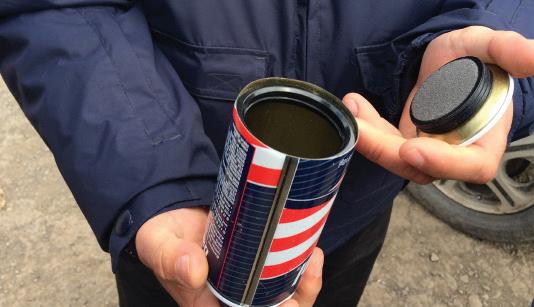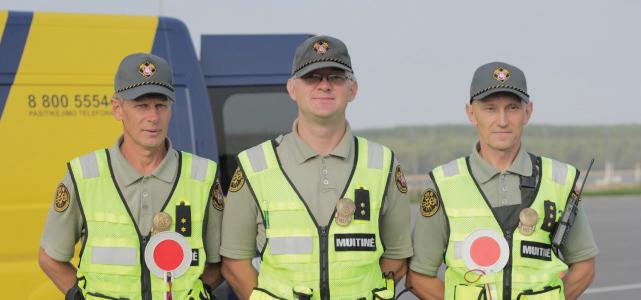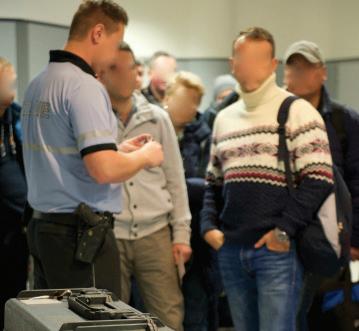
6 minute read
What is NSDD?
The vision of the U.S. Department of Energy/National Nuclear Security Administration’s (DOE/NNSA) Office of Nuclear Smuggling Detection and Deterrence (NSDD) is a world with a layered nuclear security infrastructure to prevent smuggling of radioactive and nuclear (R/N) material. The threat of R/N terrorism is real and continuing and the current international security environment is complex and continuously evolving. NSDD uses a systematic and disciplined approach to pursue its mission to prevent and investigate the smuggling of R/N materials before those materials can be used against the United States or its interests.
SUPPLY IS PLENTIFUL While much progress has been made to secure R/N materials, they remain prevalent throughout the world. Over 30 countries possess enriched uranium and separated plutonium stored at hundreds of sites. Over 100 countries possess radioactive materials stored at thousands of sites.
Advertisement
NUCLEAR SMUGGLING THREAT
The possibility that a terrorist organization or other adversary of the United States could obtain R/N materials has been a major concern since the end of the Cold War. The consequences of the weaponization of such material by competent individuals could be catastrophic in terms of lives lost, property destroyed, and fear created.
The threat of nuclear smuggling involves supply, demand and the ability to unite the two.
Country declarations to the IAEA and recurring press reports on the loss and interdiction of R/N materials confirm these materials frequently fall out of regulatory control.
DEMAND EXISTS In recent years, various adversaries of the US have employed chemical weapons and have expressed interest in acquiring and weaponizing R/N materials.
Over the past 5 years, the IAEA Incident and Trafficking Database has recorded over 65 incidents involving unauthorized possession of R/N materials and related criminal activities. A further 200 incidents involved radioactive or nuclear material out of regulatory control. Many of these incidents involved theft.
UNITING THE TWO Many countries in the world—frequently source countries of R/N materials and their neighbors— exhibit environments conducive to smuggling. These are environments in which officials are corruptible, policing and enforcement functions are weak or non-existent, smuggling routes for numerous products are developed, terrorist organizations operate, and poorly regulated commercial links with source countries exist. The concern that such environments would be leveraged by smugglers of R/N material is not theoretical. Recently reported cases of smuggling interdictions in Moldova and Georgia indicate that sellers are able to acquire R/N materials and sell them on a black market. The threat of a terrorist attack using an improvised nuclear device or radioactive dispersal device is real and sobering. The potentially catastrophic consequences of such an event obligate us to take concrete actions at reducing this threat. Drawing upon nearly two decades of experience deploying radiation detection systems internationally and the knowledge and experience of DOE/NNSA national laboratory scientists, NSDD provides world-class assistance and guidance to partner countries seeking to reduce the risk of R/N terrorism.





HISTORY
NSDD began in 1998 as a bilateral program between the U.S. Department of Energy (DOE) and Russia’s Federal Customs Service. Its goal was to prevent the smuggling of nuclear and radioactive materials through Russian air, land, and sea border crossing points (BCP). It was the first program of its kind between the U.S. and Russian governments.
In 2000, NSDD moved from DOE to the newly-established National Nuclear Security Administration. NSDD worked alongside the Material Protection, Control, and Accounting (MPC&A) Program, which provided security upgrades to Russia’s nuclear enterprise. The MPC&A Program and NSDD represented, respectively, the first and second lines of defense against the smuggling of R/N materials out of Russia.
After September 11, 2001, NSDD started to expand to other highpriority countries. Drawing upon the success of its work in Russia, NSDD worked together with law-enforcement throughout the Caucasus, Central Asia, Southern Europe, Central Europe, East Europe, and the Middle East. This was the basis of NSDD’s “Core Program”: comprehensive pathway coverage at BCPs in countries residing along potential smuggling routes.
In 2003, NSDD’s Megaports Initiative began. Its focus was screening cargo containers for R/N materials at high-threat, high-volume seaports. NSDD worked closely on complimentary missions with interagency partners including the U.S. Department of Homeland Security’s Container Security Initiative and the Secure Freight Initiative.
In consideration of evolving threats and in cooperation with existing partners, NSDD started to look beyond BCPs in 2007. NSDD’s Mobile Detection Systems Program enabled lawenforcement agencies to conduct radiation detection operations at a wide variety of strategic locations –between BCPs, at internal checkpoints, at major public events, and at other locations requiring more nimble detection capability.
Strategic reviews which began in 2012 included in-depth analyses of evolving and emerging threats and assessment of potential counter measures. This resulted in the establishment of three new, important initiatives: NSDD’s Maritime Vector Partnership, the Strategic Airports Initiative, and the Green Border Security Initiative. Each initiative focuses on addressing smuggling pathways for R/N materials which are not addressed by other parts of the Program. Further, each offers new technologies and techniques that feature targeting along with enhanced and steady state monitoring.
After a reorganization in 2015, NSDD incorporated nuclear forensics into its mission. This development helped NSDD strengthen partners’ capabilities to analyze nuclear and radioactive materials, a necessary step in the successful prosecution of smuggling incidents.
Throughout its 20-year history, NSDD has focused not only on deploying technologies and techniques but also on ensuring systems remain fully functional and operational. NSDD has been very successful in transferring the costs and responsibilities of sustaining radiation detection systems to its foreign partners.
Based on two decades of experience and partnerships with over 70 countries, NSDD has developed a unique set of capabilities that make it ideally poised to lead the effort to build international capability to deter, detect, and investigate R/N smuggling.
NSDD TODAY
TRULY GLOBAL NSDD has established partnerships with more than 100 agencies in over 70 countries on six continents, expanding the global commitment to prevent R/N smuggling.
INTERNATIONALLY INTEGRATED
By working in multiple international venues NSDD is able to promulgate best practices in countering R/N smuggling and expand the technical expertise in nuclear forensics. Access to NSDDdeveloped manuals and guides are readily available to all NSDD partners. EVOLVING AS A DETERRENT Though difficult to quantify, NSDD’s approach to a multi-layered and integrated detection network has made an impact on global security. Many partners report anecdotal information demonstrating the degree to which combined efforts have complicated the task of the would-be R/N material trafficker.
MATURE What started in the 1990s as an early effort to contain “loose nukes” has matured in all facets. An array of tools including equipment, training, and other support provides flexibility and scale for the unique needs of law enforcement and security operations. The community of participating agencies share a steady flow of new ideas and operational needs, which has developed into internationally-recognized standards and strategies for effective counter nuclear smuggling efforts.
LOOKING TO THE FUTURE For all that has been accomplished in 20 years, however, the constantly-changing landscape of threats and risks, and the spreading of old and emergence of new adversaries, mandates continued focus on the threat that is nuclear terrorism.






